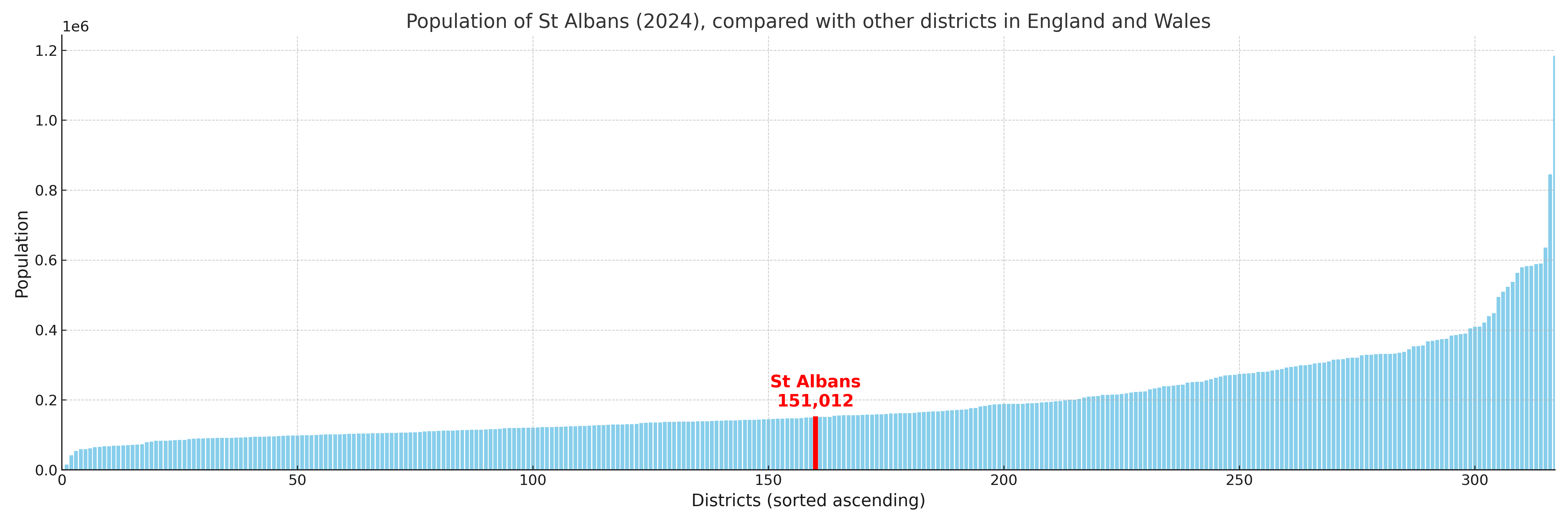St Albans
§ This page gives an overview of the St Albans local authority district, bringing together key facts, maps, and data to help you quickly understand the area. One of 361 district profiles on Baseview.
Overview ⁞ St Albans is a historic cathedral city in Hertfordshire, renowned for its Roman heritage and medieval landmarks. At its heart stands St Albans Cathedral, a magnificent structure with origins dating back to the 8th century, while Verulamium Park preserves remnants of the Roman city, including mosaics and an amphitheatre. The city centre is lined with historic buildings, lively markets, and cultural venues, blending history with modern life. Surrounding the city are greenbelt countryside and picturesque villages, with the River Ver winding through. Its mix of Roman ruins, medieval streets, and open landscapes creates a distinctive character.
St Albans Boundary Map
This map shows the official boundary of the St Albans local authority district, based on the latest geographic data published by the Office for National Statistics (ONS). It provides a clear view of the district’s extent and helps you understand how the area fits within the wider regional and national landscape.
Contains OS data © Crown copyright and database right 2025. Source: Office for National Statistics licensed under the Open Government Licence v3.0.
The administrative boundary of St Albans can also be viewed on OpenStreetMap: District Boundary of St Albans.
Key Facts about St Albans
What region is St Albans in? St Albans is in the East of England of England, a region within the UK.
What county is St Albans in? St Albans is located in the county of Hertfordshire.
Is St Albans a city? Yes, St Albans is a city. St Albans holds official city status as one of the 76 designated cities in the UK.
Who governs St Albans? The local authority for this district is: St Albans City Council - responsible for district-level services. Since Hertfordshire is a two-tier area, county-level services are handled by: Hertfordshire County Council.
▶ Official website of St Albans City Council 🔗 stalbans.gov.uk

Which police force covers St Albans? Policing in St Albans is provided by Hertfordshire Constabulary 🔗 herts.police.uk, which serves 10 local authority districts: Broxbourne ⁞ Dacorum ⁞ East Hertfordshire ⁞ Hertsmere ⁞ North Hertfordshire ⁞ St Albans ⁞ Stevenage ⁞ Three Rivers ⁞ Watford ⁞ Welwyn Hatfield.
Constituencies in St Albans
St Albans is divided into 2 parliamentary constituencies, listed below in alphabetical order.
A constituency is a specific geographical area that elects one Member of Parliament (MP) to represent them in the House of Commons. The United Kingdom is divided into 650 parliamentary constituencies. We have this list page for easy browsing of all UK parliamentary constituencies: List of Constituencies.
Wards in St Albans
St Albans is divided into 20 wards, listed below in alphabetical order.
- Batchwood
- Bernards Heath
- Clarence
- Colney Heath
- Cunningham
- Harpenden East
- Harpenden North & Rural
- Harpenden South
- Harpenden West
- Hill End
- London Colney
- Marshalswick East & Jersey Farm
- Marshalswick West
- Park Street
- Redbourn
- Sandridge & Wheathampstead
- Sopwell
- St Peters
- St Stephen
- Verulam
In the UK, a ward is a subdivision of a local authority area, used mainly for electoral and statistical purposes. Defined by the ONS, wards represent the primary unit for local elections, each returning one or more councillors to the local council. Wards are also used as a key geography for presenting population and census data.
Parishes in St Albans
St Albans is part-parished: 9 civil parishes (listed A-Z below) alongside 2 unparished areas.
- Colney Heath
- Harpenden Rural
- Harpenden Town
- London Colney
- Redbourn
- Sandridge
- St Michael
- St Stephen
- Wheathampstead
A civil parish is the lowest tier of local government in England, used for villages, small towns, and suburbs. They have their own local authority, either a parish council or a parish meeting, which provides local services like managing parks, allotments, and streetlights, and represents the community's views to larger councils.
Built-up Areas in St Albans
St Albans covers 22 built-up areas, listed below in alphabetical order.
- Bedmond *
- Blackmore End *
- Bricket Wood *
- Chiswell Green
- Colney Heath *
- Colney Street *
- Friar's Wash *
- Harpenden *
- Hatfield *
- Hemel Hempstead *
- Kinsbourne Green
- Lea Valley
- London Colney *
- Park Street and Frogmore
- Radlett *
- Redbourn
- Sandridge
- Shenleybury *
- Smallford
- St Albans
- Watford (Watford) *
- Wheathampstead
In the UK, a Built-up Area (BUA) is a continuous urban area of at least 20 hectares (0.2 km²), defined by the ONS as land where buildings are generally no more than 200 metres apart, such as towns, cities, or large villages. (Note: A BUA name marked with an asterisk (*) indicates that the area is situated partly in the district of St Albans.)
St Albans compared with other districts in the UK
This section shows how St Albans compares with other local authority districts in the UK, using a variety of measures and rankings.
St Albans has 20 electoral wards.

St Albans has a population of 151,012 (2024 mid-year estimate by ONS)

More local statistics and data for St Albans can be found on the ONS statistics for St Albans.